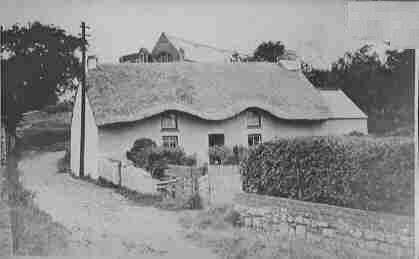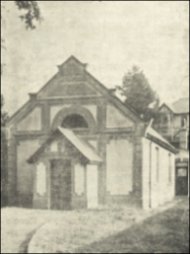ENGLISH BAPTIST CHURCH
and
BRYNMAWR LANE
(LÔN BRYN-MAWR)Brynmawr Lane
The original name given by the Dynevor Estate to the little road now leading off College Street to All Saints Church was Fitzwilliam Road. But on the outbreak of the First World War a German connection to the name caused embarrassment and the street name was diplomatically changed to Brynmawr Lane. An appropriate name at least, as the road was actually formed on the access lane leading to the farmstead of Brynmawr. Ammanford was not alone in expunging all things Germanic from sight during the war and they were in illustrious company: the Royal family themselves set the trend when they changed their dynastic name from Sax-Coberg-Gotha to the House of Windsor. Sax-Coberg-Gotha, the family name of Queen Victoria's German husband, Albert, was hardly appropriate after all for a nation now at war with Germany. The monarch's cousin, Earl Battenberg, also changed his name to Mountbatten, though the cake of that name has stayed the same despite another war with Germany since then.
The translation of Brynmawr is 'big hill' and the land attached to the farm encloses what is now commonly known as the Gorsedd. It is not as big a hill as its name would suggest, but it certainly is land elevated above the valley plain. The mound was formed during the glacial epoch of the Ice Age and in geological terms is an eskar block, or moraine.
In 1803 the then owner of the holding, Lord Dynevor, commissioned a Mr. Matthew Williams to survey and record the property. From the architectural features of the farmstead itself, a typical Welsh thatched cottage, it can undoubtedly be dated to a much earlier period, probably to the early 1700s.
The farm ceased to be a viable unit over the years as its farmlands were remorselessly encroached upon by the ever-expanding town development. The 1891 Census records show that the resident was a William Jones whose occupation was described as a gardener. In latter years, the cottage became a rented dwelling, administered by the Dynevor Estate. During the Second World War the thatched roof was completely covered with galvanized iron sheeting in what appeared to be an attempt to keep the structure watertight.
On the death of the elderly tenant re-letting became a problem as the property lacked all modern conveniences: even the water supply was obtained from an outside tap. As the farm was uneconomical to modernise, the Dynevor Estate obtained consent from the Ammanford Urban District Council in April 1950 to demolish the building and clear the site for redevelopment, and two residences, 'Heddwyn' and No 1 Brynmawr Lane, were subsequently built within the garden and enclosure of the old cottage.
On reflection, the decision to raze such a delightful early-period Welsh cottage can only be described as vandalism, an activity that property developers and local councils are particularly good at.
Prior to making-up the dirt lane to a paved road under the Private Street Works, in 1970 the Ammanford Urban District Council obtained a Magistrate's Order to close up the junction (for vehicular traffic) to Brynmawr Avenue and Brynmawr Lane has from that time on been a cul-de sac, with entry leading off College Street.
The English Baptist Church
English Baptist Church in Brynmawr Lane had once been Watcyn Wyn's school, named the Hope Academy. Later the school transferred to Gwynfryn, built in a field next door. The outbuildings of the Farm, situated on the opposite side of the road to the farmstead of Brynmawr, have strong links with Ammanford's educational history. In 1880 they were converted into an educational centre by the Rev. Watcyn Hezekiah Williams (better known by his bardic name of Watcyn Wyn) which he named the Hope Academy. This served as a preparatory school to educate young adults to a level for acceptance into theological colleges. Then, in 1888, he built a new home on adjoining land which became the Gwynfryn School and so released Hope Academy for other uses.
The Rev. David Davies, then Vicar of the Parish of Llandybie (Ammanford at that time being part of his Parish) recognised the need of a church in the area and by agreement the Hope Academy premises were used as a place of worship, and was dedicated by the Bishop of Saint David's on the 24th of July 1882, 'for the performance of Divine Service and Celebration of Holy Sacraments'. With the completion of St Michael's church on Wind Street in 1885 these premises became surplus to Church requirements. All Saints church was built in 1915, just a few yards away, and when its clock tower was added in 1923 the church building in Ammanford was complete.
In the early 20th century the building, once a barn, next a school room, then a church, again took on a new role, though still within the Christian fraternity, as an English Baptist Church, the use for which it still stands today. Services are held at 11 am every Sunday and a warm welcome is assured for any one attending.
When this little English chapel was built Ammanford already had a large Baptist Church, built in 1850 and enlarged to its present size in 1877, but this was, and still is, for services in Welsh. Although the Amman Valley was at this time over 90 percent Welsh speaking there was still demand for churches to cater for an English speaking minority that was migrating into the valley in search of work in the local coal mines and associated industries. As a result several, though much smaller, churches were built in the town to serve this purpose. It's relatively easy to spot some of them as they carry the word 'English' before their denominational name, a hint if ever there was one - English Baptist, Brynmawr Lane (founded in 1905); English Congregationalist, Iscennen Road, (built 1913); and English Wesleyan, Wind Street, (built 1875). Some other English-language churches in the town aren't so thoughtful as to provide this assistance, so you need to know beforehand that St Thomas Church, Pontamman (opened around 1890); All Saints Church, Church Street, (built 1915); the Apostolic Church (Iscennen Road); the Evangelical Church, Wind Street, (opened 2003); the Gospel Hall, Lloyd Street, (opened 1911); or the Christadelphians (Pontamman) hold their services in English.
An influx of English-speaking Baptists who'd come from Monmouthshire to work in local industries could initially only worship at Ebeneser, where the services were all in Welsh. Then the Welsh Revival of 1904/05 resulted in a dramatic increase in church attendance, of both Welsh and English speakers, and the English-speaking Baptists in Ammanford were also to benefit from an increase in both enthusiasm and members. A item in the Carmarthen Journal of July 14th 1905 reports that 80 people had signed a petition to form an English Baptist church (the Amman Valley didn't have its own newspaper until the Amman Valley Chronicle appeared on the streets in 1913). Another Carmarthen Journal report on 26th August 1906 reports that separate English services were now being held at Ebeneser chapel. By 1908 the church had enough funds to appoint its first full-time minister, one Morgan Thomas, initially for one year, and started using the premises on Brynmawr Lane they still occupy today.
But by December 1911 the church was in financial difficulties and had to release Morgan Thomas, though the chapel's minute book also records that there were "unpleasant feelings between Pastor and members." But the real reason, and one not recorded in the chapel's minute book, was that there was a split in the church and for a while there were two English Baptist churches in Ammanford. A report in the newly published Amman Valley Chronicle of September 4th 1913 refers to "English Baptist church (two places of worship)". The second Baptist church was located on Station Road, Tirydail, in a building that had been the temporary home of the town's Christadelphians, Welsh Wesleyans and finally St John's Church, a versatile little building indeed. Meanwhile the original English Baptists were without a minister until 1917 though the faithful were eventually able to purchase the Brynmawr Avenue building in 1919 with the freehold purchased from Lord Dynevor in 1960.
The church wasn't solemnised to perform marriage ceremonies until 23rd June 1938 and still cannot perform the sacrament of Believers' Baptisms to this day, which have been carried out, when required, at Ebeneser.
The original building, which has served as a school and a church before the Baptists took up residence, was adapted and renovated on its purchase in 1919 and received another major renovation in 1937, and a vestry was added in 1961. Since 1968 English Baptists haven't had a full time minister, utilising the services of a part-time minister from 1993 until 2004 and various local preachers in this time. This is becoming an increasingly common practice for other denominations, too, and the country-wide decline in church membership is compounded by a shortage of ordained ministers entering divinity colleges.
The Church's history, published in their centenary year of 2005, concludes with these words:
... we are still here. A faithful remnant seeking to keep the door open and continuing to serve the church and the local community. As we travel forward as pilgrims, we are reminded of the words of John Robinson, a Pilgrim Father of the 17th century, "the Lord has yet more light and truth to shine forth from His Holy Word".
Sources: – WTH Locksmith: Ammanford: Origin of street names and notable historic records, 2000. – W. Adrian Walters: The English Baptist Church, Ammanford, 1905-2005, 2005.


